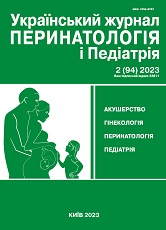Level of postoperative complications in surgical pathology of the abdominal cavity and pelvic cavity in girls
DOI:
https://doi.org/10.15574/PP.2023.94.57Keywords:
complications, adhesion disease, children, operative treatment, minimally invasive surgical interventions, girls, hynecological pathologyAbstract
The frequency of the development of adhesion disease after surgical interventions on the abdominal cavity is 63-93%. In women who have complications, in the form of confirmed adhesion disease, there is infertility and miscarriage, menstrual cycle disorders in 60% of cases. It should be noted that among women with adhesions, 8.02% had ectopic pregnancies. In addition, every fifth woman with adhesions in the abdominal cavity has endometriosis - 3.08% of cases. Postoperative complications in patients operated on for acute appendicitis are 4-15%, and the mortality rate of acute appendicitis is 0.1-10%.
Purpose - to analyze the level of postoperative complications in girls operated on for acute surgical pathology of the pelvic organs by laparoscopic or laparotomy methods.
Materials and methods. An analysis of the treatment of 297 girls who were undergoing inpatient treatment for surgical pathology of the pelvic organs at the Pediatric Surgery Clinic of National Pirogov Memorial Medical University, Vinnytsia, Ukraine on the basis of the Vinnytsia Regional Pediatric Clinical Hospital of the Vinnytsia Regional Council during 2018-2022.
Results. In children who underwent laparoscopic appendectomy, the rate of postoperative complications was 8 times lower compared to open methods. The use of laparoscopic technologies in the treatment of gynecological pathology in girls, in particular, in teenagers, allowed to reduce the number of postoperative complications by 5 times.
Conclusions. In general, it should be recommended, according to indications, to introduce into clinical practice laparoscopic methods of diagnosis and treatment of surgical pathology of the abdominal cavity and pelvic cavity.
The research was carried out in accordance with the principles of the Declaration of Helsinki. The research protocol was approved by the Local Ethics Committee of the institution mentioned in the work. Informed consent of the children’s parents was obtained for the research.
No conflict of interests was declared by the authors.
References
Bodnar OB. (2003). Likuvannia ta profilaktyka spaikovoi khvoroby v ditei pislia perenesenykh hostrykh khirurhichnykh zakhvoriuvan orhaniv cherevnoi porozhnyny (kliniko-eksperymentalne doslidzhennia). Avtoref. dys. … kand. med. nauk : 14.01.09. Donetsk : INVKh: 18.
Khashchuk VS, Khashchuk VS. (2021). Mekhanizmy rozvytku spaikovoho protsesu ocherevynnoi porozhnyny (ohliad literatury). Klinichna ta eksperymentalna patolohiia. 4 (78): 137-145.
Pereyaslov AA, Dvorakevych AA, Bobak AI, Mykyta MM et al. (2019). Comparative analysis of the open and laparoscopic appendectomy in children. Pediatric Surgery.Ukraine. 4 (65): 43-47. https://doi.org/10.15574/PS.2019.65.43.
Plotnikova AS. (2022). Osoblyvosti poslioperatsiinoho periodu pislia apendektomii (ohliad literatury). XXII International scientific and practical conference «Multidisciplinary academic research, innovation and results», Prague, Czech Republic, June 07-10 2022. Librarianship, Brisbane: 411-412.
Rusak PS, Tolstanov ОК, Rybalchenko VF, Stakhov VV, Voloshin YL. (2020). Problematic issues of diagnosis and treatment of acute appendicitis in children. Paediatric Surgery. Ukraine. 3 (68): 28-36. https://doi.org/10.15574/PS.2020.68.28.
Rusyn VI, Chavarha MI. (2013). Vybir metodu sanatsii cherevnoi porozhnyny yak zasib profilaktyky spaikovykh uskladnen pry likuvanni uskladnenykh form hostroho apendytsytu u ditei. Naukovyi visnyi Uzhhorodskoho universytetu. 1 (46): 118-121.
Shaganov PF. (2018). Retrospektyvnyi analiz anamnezu zhinok iz naiavnistiu spaikovoi khvoroby. Visnyk naukovykh doslidzhen. 4: 98-102. https://doi.org/10.11603/2415-8798.2018.4.9817
Shymko VV, Pustovii IA, Kupriienko MM. (2016). Dosvid limfotropnoi terapii pry destruktyvnykh formakh hostroho apendytsytu. Zhurnal klinichnykh ta eksperymentalnykh medychnykh doslidzhen. 2 (4): 278-282.
Downloads
Published
Issue
Section
License
Copyright (c) 2023 Ukrainian Journal of Perinatology and Pediatrics

This work is licensed under a Creative Commons Attribution-NonCommercial 4.0 International License.
The policy of the Journal “Ukrainian Journal of Perinatology and Pediatrics” is compatible with the vast majority of funders' of open access and self-archiving policies. The journal provides immediate open access route being convinced that everyone – not only scientists - can benefit from research results, and publishes articles exclusively under open access distribution, with a Creative Commons Attribution-Noncommercial 4.0 international license(СС BY-NC).
Authors transfer the copyright to the Journal “MODERN PEDIATRICS. UKRAINE” when the manuscript is accepted for publication. Authors declare that this manuscript has not been published nor is under simultaneous consideration for publication elsewhere. After publication, the articles become freely available on-line to the public.
Readers have the right to use, distribute, and reproduce articles in any medium, provided the articles and the journal are properly cited.
The use of published materials for commercial purposes is strongly prohibited.

